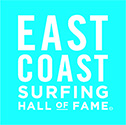Tom Blake*
Tom Blake grew up on the shores of Lake Superior in Washburn, Wisconsin, where the waves are rarely high enough to catch anything resembling a real wave. It was an educational film shown at his high school that gave Blake his first exposure to the sport of surfing.
After graduation, he set out to live the nomadic lifestyle that would characterize most of his life, working a succession of jobs in Detroit, New York and Miami. At a Detroit movie theater in 1920, he bumped into legendary Hawaiian surfer Duke Kahanamoku; they shook hands and Blake later reported to his biographer, Gary Lynch, “I felt that somehow he had included an invitation to me to come over to his own Hawaiian Islands.” The two would later become good friends, and Blake became the link between the ancient form of surfing from the South Pacific and the modern version of the sport that would sweep America.
Blake was based in Los Angeles throughout the 1920s, where he worked as a lifeguard and occasionally stunt doubled for movie stars like Clark Gable and Ramon Navarro. He rose to prominence in the surfing world over the course of the next two decades, making frequent trips to Hawaii to visit the Kahanamoku brothers and winning the first Pacific Coast Surfriding Championship. He also set a record that stands to this day: on August 1, 1936, he entered the waves at Kalehuawehe, near Waikiki, and proceeded to make a 4,500-foot run, the longest recorded surf ride in history.
Inspired by the traditional boards he saw on display in Honolulu’s Bishop Museum, Blake began experimenting with the design of modern surfboards. In 1931, he received a patent for his hollow surfboard design, opening the sport to hundreds of people who were unable to handle the heavy plank boards typical of the time. Blake was also responsible for adding the “skeg,” or fin, to boards for added control — a design element that remains integral in all surf and paddleboard construction.
Blake’s creations and inventions weren’t limited to surfing. He is credited with crafting the first windsurfing board, and used engineering takeaways from working on watercraft to innovate lifesaving equipment. He also developed an early prototype for an underwater camera—photo essay of his adventures beneath the waves was published in a 1935 issue of National Geographic. A prolific writer, Blake published several books and articles, including Hawaiian Surfboard, considered the first book on surfing.
Blake is widely described as one of the most significant figures in the history of surfing for his athletic achievements, his innovations in board design, his success in popularizing the sport, and for his role in pioneering what came to be known as “the surfing life.” In 2001, journalist Drew Kampion wrote, “Blake altered everything. He almost single-handedly transformed surfing from a . . . Polynesian curiosity into a 20th-century lifestyle.”






